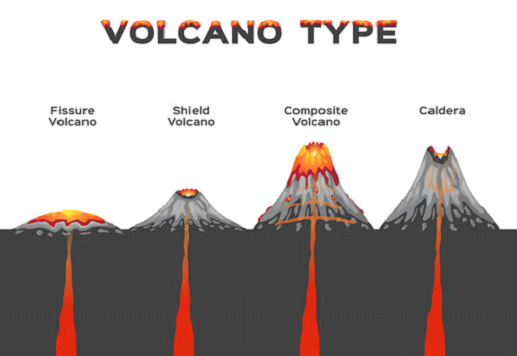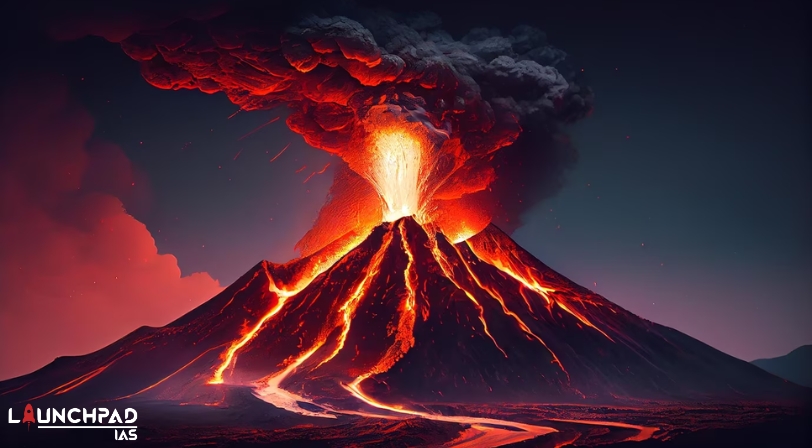A volcano is an opening in the earth’s crust through which gases, molten rock materials (lava), ash, steam, etc. are emitted outwards in the comes of an eruption. Such vents and openings occur in those parts of the earth’s crust where rock strata are relatively weak.
- Magma released by the volcano makes different types of landforms. Landforms made by volcanos can be divided into intensive and extensive landforms. If the magma reaches the outer surface of the earth’s crust and cooling of magma takes place outside, then they are called extrusive igneous rocks. The rocks formed by such actions are basalt, andesite, etc.
- And if cooling takes place in the crust and not over the surface, they are called intrusive igneous rocks. Rocks formed through such actions are granite, gabbro, diorite, etc. Intrusive igneous rocks are classed into the following types according to their forms.

Difference between Magma and Lava:
- Magma is the term used to denote the molten rocks and related materials seen inside the earth. A weaker zone of the mantle called asthenosphere, usually is the source of magma.
- Once this magma comes out to the earth’s surface through the vent of a volcano, it is called the Lava. Therefore, Lava is nothing but the magma on the earth’s surface.
- The process by which solid, liquid, and gaseous material escape from the earth’s interior to the surface of the earth is called Volcanism.
Volcano Type
Volcanoes are classified based on the nature of eruption and the form developed at the surface.

Shield Volcanoes:
- How to identify: They are not very steep but are far and wider. They extend to great height as well as distance.
- They are the largest of all volcanoes in the world as the lava flows to a far distance. The Hawaiian volcanoes are the most famous examples.
- Shield volcanoes have low slopes and consist almost entirely of frozen lavas.
- If you were to fly over the top of a shield volcano, it would resemble a warrior’s shield, hence the name.
- These volcanoes are mostly made up of basalt (less viscous), a type of lava that is very fluid when erupted. For this reason, these volcanoes are not steep.
- They are low explosive in general, but if somehow water gets into the vent they may turn explosive.
- The upcoming lava moves in the form of a fountain throws out the cone at the top of the vent and develops into a cinder cone.
Cinder Cone Volcanoes:
- Cinders are extrusive igneous rocks. A more modern name for cinder is Scoria.
- Small volcanoes.
- These volcanoes consist almost entirely of loose, grainy cinders and almost no lava.
- They have very steep sides and usually have a small crater on top.
Composite Volcanoes:
- Shape: Cone-shaped with moderately steep sides and sometimes have small craters in their summits.
- Volcanologists call these “strato-” or composite volcanoes because they consist of layers of solid lava flows mixed with layers of sand- or gravel-like volcanic rock called cinders or volcanic ash.
- They are characterized by the eruption of cooler and more viscous lavas than basalt.
- These volcanoes often result in explosive eruptions.
- Along with lava, large quantities of pyroclastic materials and ashes find their way to the ground.
- This material accumulates in the vicinity of the vent openings leading to the formation of layers, and this makes the mount appear as a composite volcano.
Caldera:
- These are the most explosive of the earth’s volcanoes.
- They are usually so explosive that when they erupt they tend to collapse on themselves rather than building any tall structure. The collapsed depressions are called calderas.
- Their explosiveness indicates that its magma chamber is large and in close vicinity.
- A caldera differs from a crater in such a way that a caldera is a huge depression caused by a collapse after a large-scale eruption, whereas a crater is a small, steep side, volcanic depression bored out by an eruptive plume.
Flood Basalt Provinces
- These volcanoes outpour highly fluid lava that flows for long distances.
- The Deccan Traps from India, presently covering most of the Maharashtra plateau, are a much larger flood basalt province.
Mid-Ocean Ridge Volcanoes
- These volcanoes occur in the oceanic areas.
- There is a system of mid-ocean ridges more than 70,000 km long that stretches through all the ocean basins.
- The central portion of this ridge experiences frequent eruptions.
Also, check out: CYCLONE


